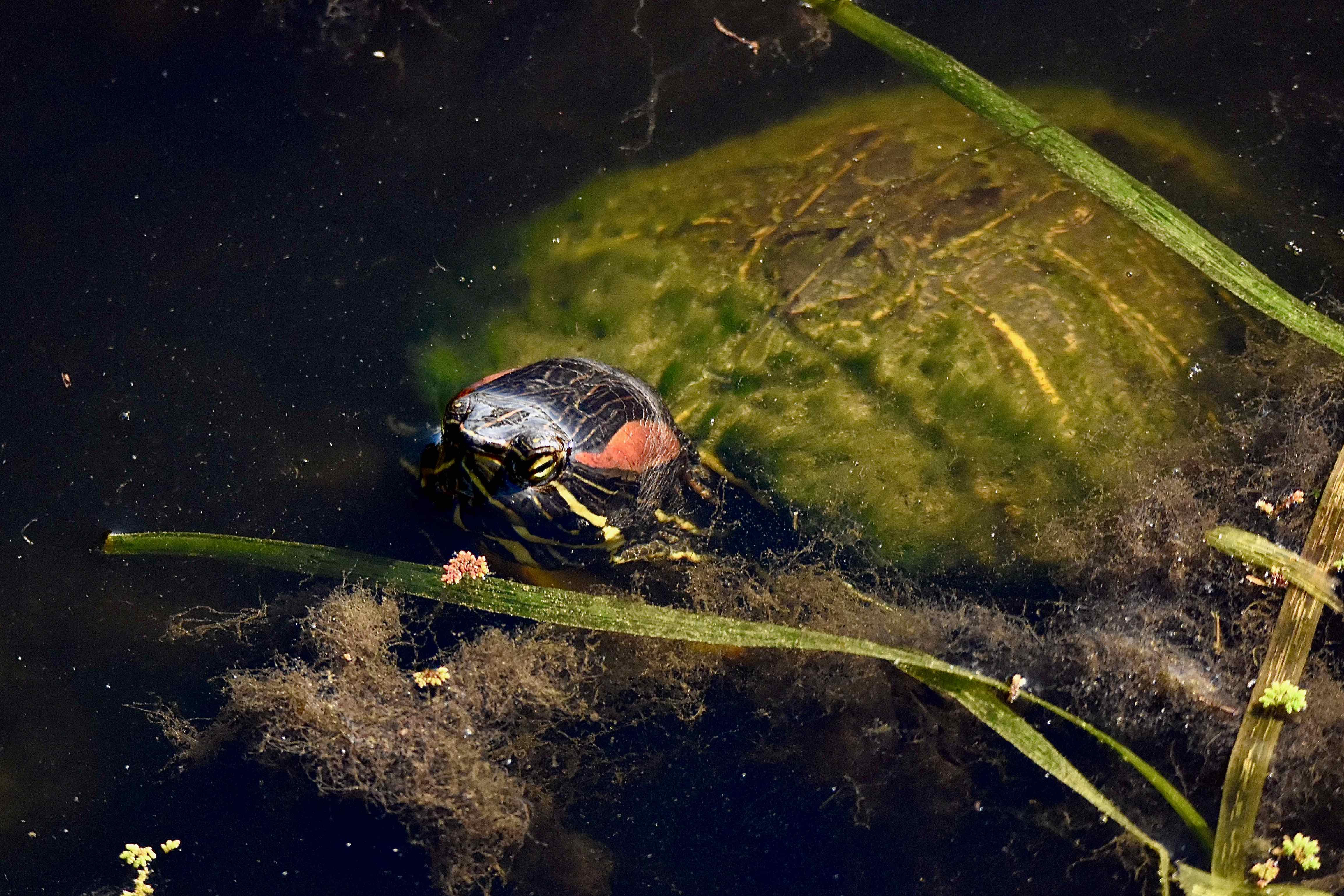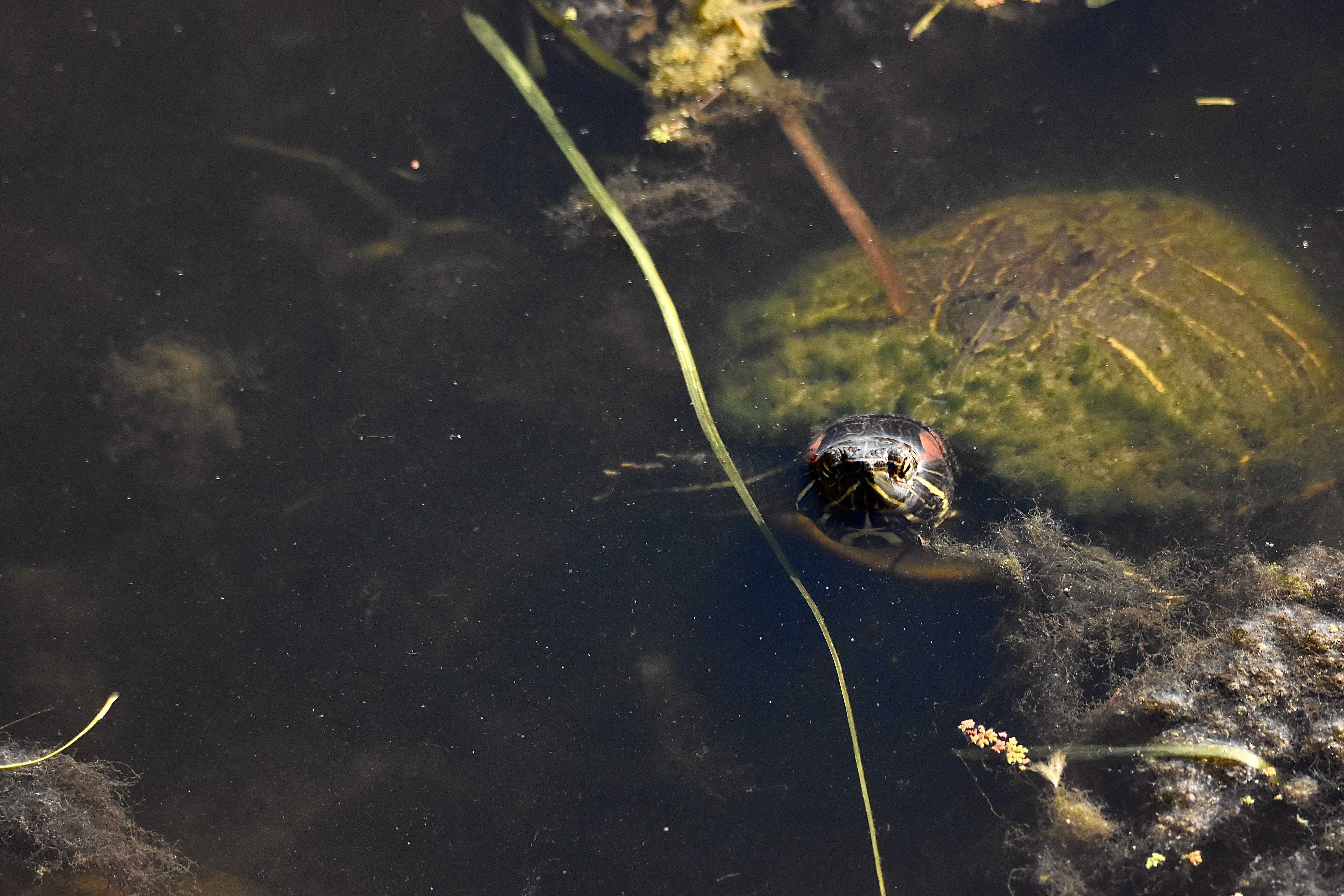
Red-eared slider, photographed at Plantation Preserve Linear Trail, Plantation, Broward County, in February 2018.
If you had a turtle as pet back in the 1960s and early 1970s — and a lot of people did — it was almost certainly this guy, the red-eared slider, AKA Trachemys scripta elegans.
The red-eared slider was, in fact, one of the most highly traded turtles in the world — and still is, not just for the pet business but for its meat as well. Not surprisingly, considering how these things work, it's also among the most invasive creatures on the planet. Florida banned both the sale and possession of red-eared sliders in July 2007.
Red-eared sliders are natives of the Mississippi River Valley as far north as Missouri and Illinois, south to the Delta and as far east as southern West Virginia.
They're marked by the red stripe that sits behind the eyes, about where you might expect ears to be. Hatchlings are green with yellow strips, but darken to almost black as they age. They have long claws on the front feet.
Adult females can be as long as 12 inches, males smaller. They seldom leave the water except to bask in the sun. Red-eared sliders are omnivores, eating plants, bugs, fish, frogs, snakes among other tasty morsels. Young turtles eat mostly meat, older ones more plant stuff.
Males reach maturity between two and five years, females at eight years. Females will lay as many as five clutches a year, each with two to 23 eggs, mostly nesting between April and July. They can live as long as 40 years.
Back in the heyday of the turtle trade, retailers sold red-eared sliders by the hundreds of millions; it was the easily the most commonly exported reptile from the United States, finding homes on every continent save Antarctica. They were cheap and easy to care for — give them a small tank, a place to bask, some food and they're good to go.
Or so it seemed. Problem was that young sliders needed a whole lot more care then they received and, consequently, most died. In the mid-1970s, the feds stepped in and banned the sale of red-eared sliders less than four inches long. The reason: scientists discovered red-eared sliders smaller than that often carried salmonella bacteria. But sales surged again in the 1980s with the popularity of the Teenage Mutant Turtles, which are supposedly red-eared sliders. According to the California Fish and Wildlife Service, the United States exported 52 million sliders between 1989 and 1997.
The problem with exotic pets generally is that too many owners tire of caring for their animals or can't take care of them as they get bigger. Instead of properly disposing them, they dump them into the wild as a "humane" solution. Thing is red-eared sliders are aggressive animals and will outcompete native species for food and living space. In ponds with large numbers of red-eared sliders, the prodigious amount of waste they dump can set off algae blooms.
In Florida, the primary victim is the native red-bellied slider; in some areas, red-eared sliders outnumber native red-bellied sliders. In Japan, there are eight times as many red-eared sliders as there are all native turtle species combined.
According to the U.S. Geological Survey, red-eared sliders now inhabit most of the Peninsula and all of South Florida. Red-eared sliders threaten a second native species in Florida, the yellow-bellied slider, Trachemys scripta scripta. The two turtles are close cousins and will interbreed, potentially reducing the native yellow-bellied population
Florida became the first state to ban the sale and possession of red-eared sliders in 2007. It did allow commercial turtle farms to continue operating in the state as long as they sold their sliders someplace other than Florida. Other places have followed suit, including the European Union.
Still, growing red-eared sliders remains big business. Check the internet and there's no shortage of dealers that will sell you the critters, generally with the disclaimer that they won't ship to Florida. There are even vendors that sell red-eared sliders under four inches despite federal regulations. And salmonella contamination is still a problem in two ways: breeding farms use antibiotics to keep their turtles germ-free, but the pracice contributes to drug-resistant strains of salmonella. And despite the precaution, occasionally there are outbreaks of the disease linked to these turtles. A 2012 outbreak of disease that sickened nearly 500 people was traced back to exposure to pet turtles.
The trade is lucrative enough that the U.S. now imports red-eared sliders grown in farms as far away as China. But that presents a new problem. Animal rescue organizations could release unwanted pets into the wild in their native range along the Mississippi. But there are fears that imported sliders could be carrying diseases that could devastate native turtle populations.
Red-eared sliders are members of Emydidae, the pond turtle family.
Plantation Preserve Linear Trail
Photo Gallery — Click on photo for larger image



